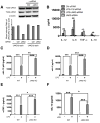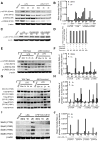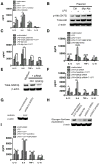The role of JAK-3 in regulating TLR-mediated inflammatory cytokine production in innate immune cells
- PMID: 23797672
- PMCID: PMC3720823
- DOI: 10.4049/jimmunol.1203084
The role of JAK-3 in regulating TLR-mediated inflammatory cytokine production in innate immune cells
Abstract
The role of JAK-3 in TLR-mediated innate immune responses is poorly understood, although the suppressive function of JAK3 inhibition in adaptive immune response has been well studied. In this study, we found that JAK3 inhibition enhanced TLR-mediated immune responses by differentially regulating pro- and anti- inflammatory cytokine production in innate immune cells. Specifically, JAK3 inhibition by pharmacological inhibitors or specific small interfering RNA or JAK3 gene knockout resulted in an increase in TLR-mediated production of proinflammatory cytokines while concurrently decreasing the production of IL-10. Inhibition of JAK3 suppressed phosphorylation of PI3K downstream effectors including Akt, mammalian target of rapamycin complex 1, glycogen synthase kinase 3β (GSK3β), and CREB. Constitutive activation of Akt or inhibition of GSK3β abrogated the capability of JAK3 inhibition to enhance proinflammatory cytokines and suppress IL-10 production. In contrast, inhibition of PI3K enhanced this regulatory ability of JAK3 in LPS-stimulated monocytes. At the transcriptional level, JAK3 knockout lead to the increased phosphorylation of STATs that could be attenuated by neutralization of de novo inflammatory cytokines. JAK3 inhibition exhibited a GSK3 activity-dependent ability to enhance phosphorylation levels and DNA binding of NF-κB p65. Moreover, JAK3 inhibition correlated with an increased CD4(+) T cell response. Additionally, higher neutrophil infiltration, IL-17 expression, and intestinal epithelium erosion were observed in JAK3 knockout mice. These findings demonstrate the negative regulatory function of JAK3 and elucidate the signaling pathway by which JAK3 differentially regulates TLR-mediated inflammatory cytokine production in innate immune cells.
Conflict of interest statement
Conflict-of-Interest Disclosure
The authors declare no competing financial interests
Figures







Similar articles
-
Convergence of the mammalian target of rapamycin complex 1- and glycogen synthase kinase 3-β-signaling pathways regulates the innate inflammatory response.J Immunol. 2011 May 1;186(9):5217-26. doi: 10.4049/jimmunol.1002513. Epub 2011 Mar 21. J Immunol. 2011. PMID: 21422248 Free PMC article.
-
Syk negatively regulates TLR4-mediated IFNβ and IL-10 production and promotes inflammatory responses in dendritic cells.Biochim Biophys Acta. 2016 Mar;1860(3):588-98. doi: 10.1016/j.bbagen.2015.12.012. Epub 2015 Dec 17. Biochim Biophys Acta. 2016. PMID: 26708990 Free PMC article.
-
Upregulation of RGS4 expression by IL-1beta in colonic smooth muscle is enhanced by ERK1/2 and p38 MAPK and inhibited by the PI3K/Akt/GSK3beta pathway.Am J Physiol Cell Physiol. 2009 Jun;296(6):C1310-20. doi: 10.1152/ajpcell.00573.2008. Epub 2009 Apr 15. Am J Physiol Cell Physiol. 2009. PMID: 19369446 Free PMC article.
-
Role of phosphoinositide 3-kinase in innate immunity.Biol Pharm Bull. 2007 Sep;30(9):1617-23. doi: 10.1248/bpb.30.1617. Biol Pharm Bull. 2007. PMID: 17827709 Review.
-
Glycogen synthase kinase 3: a point of convergence for the host inflammatory response.Cytokine. 2011 Feb;53(2):130-40. doi: 10.1016/j.cyto.2010.10.009. Epub 2010 Nov 23. Cytokine. 2011. PMID: 21095632 Free PMC article. Review.
Cited by
-
Dynamic modulation of innate immune response by varying dosages of lipopolysaccharide (LPS) in human monocytic cells.J Biol Chem. 2014 Aug 1;289(31):21584-90. doi: 10.1074/jbc.M114.583518. Epub 2014 Jun 26. J Biol Chem. 2014. PMID: 24970893 Free PMC article.
-
JAK-STAT signaling in inflammation and stress-related diseases: implications for therapeutic interventions.Mol Biomed. 2023 Nov 8;4(1):40. doi: 10.1186/s43556-023-00151-1. Mol Biomed. 2023. PMID: 37938494 Free PMC article. Review.
-
Oclacitinib, a Janus Kinase Inhibitor, Reduces the Frequency of IL-4- and IL-10-, but Not IFN-γ-, Producing Murine CD4+ and CD8+ T Cells and Counteracts the Induction of Type 1 Regulatory T Cells.Molecules. 2021 Sep 17;26(18):5655. doi: 10.3390/molecules26185655. Molecules. 2021. PMID: 34577127 Free PMC article.
-
Electret-Inspired Charge-Injected Hydrogel for Scar-Free Healing of Bacterially Infected Burns Through Bioelectrical Stimulation and Immune Modulation.Adv Sci (Weinh). 2025 Apr;12(13):e2411889. doi: 10.1002/advs.202411889. Epub 2025 Feb 14. Adv Sci (Weinh). 2025. PMID: 39951351 Free PMC article.
-
GSK3β and the control of infectious bacterial diseases.Trends Microbiol. 2014 Apr;22(4):208-17. doi: 10.1016/j.tim.2014.01.009. Epub 2014 Mar 4. Trends Microbiol. 2014. PMID: 24618402 Free PMC article. Review.
References
-
- O’Neill LA. ‘Fine tuning’ TLR signaling. Nat Immunol. 2008;9:459–461. - PubMed
-
- Foster SL, Hargreaves DC, Medzhitov R. Gene-specific control of inflammation by TLR-induced chromatin modifications. Nature. 2007;447:972–978. - PubMed
-
- Garlanda C, Di Liberto D, Vecchi A, La Manna MP, Buracchi C, Caccamo N, Salerno A, Dieli F, Mantovani A. Damping excessive inflammation and tissue damage in Mycobacterium tuberculosis infection by Toll IL-1 receptor 8/single Ig IL-1-related receptor, a negative regulator of IL-1/TLR signaling. J Immunol. 2007;179:3119–3125. - PubMed
-
- Kawai T, Akira S. TLR signaling. Semin Immunol. 2007;19:24–32. - PubMed
-
- Lee MS, Kim YJ. Signaling pathways downstream of pattern-recognition receptors and their cross talk. Annu Rev Biochem. 2007;76:447–480. - PubMed
Publication types
MeSH terms
Substances
Grants and funding
LinkOut - more resources
Full Text Sources
Other Literature Sources
Molecular Biology Databases
Research Materials
Miscellaneous

